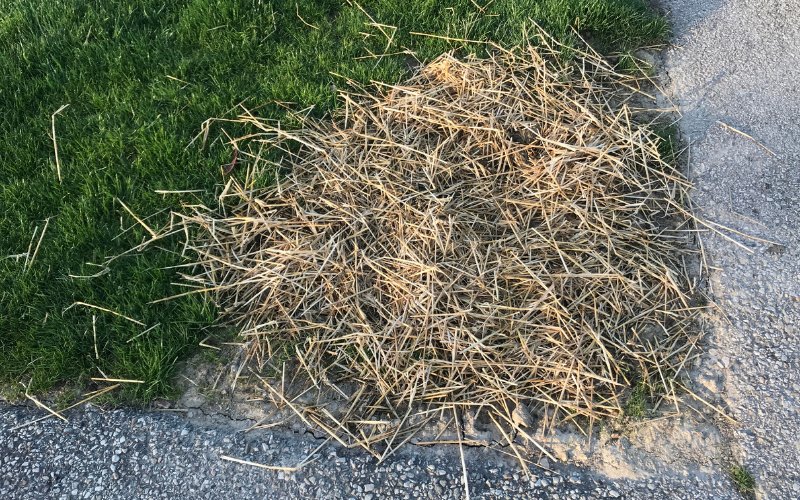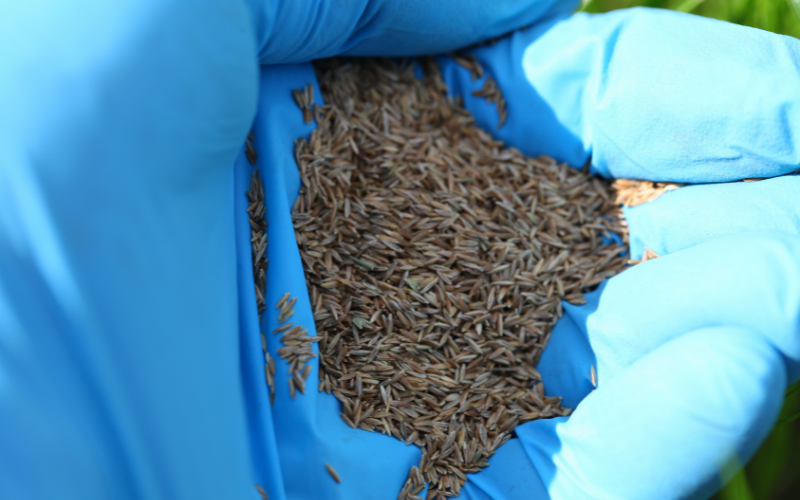At some point or other, every lawn owner will end up with a patch of dead sod or an entire lawn that’s just taken too much damage.
Whether your lawn was killed by grubs, weeds, or too much rain, overseeding or seeding over the dead grass or sod could be the easiest way to get things looking like they should.
That is, as long as you have already dealt with the root cause that led to your lawn dying in the first place.
Can You Reseed Over Dead Grass? (The Short Answer)
Can you seed over dead sod or grass? Yes, you can. This process is sometimes called “overseeding” and is a common practice.
You can seed over dead grass or sod as-is or use a variety of tips and techniques to ensure that you get the results you want with less time and expense.
How to Plant Grass Seed Over Dead Grass or Sod
Seeding over grass or dead sod can be done without any prep work and you should see adequate results. There may be a few thin patches here and there but things will likely fill in over time.
However, by following the steps outlined below you should have a more even lawn with improved health and vigor right off the bat.
This is how to plant grass seed over dead sod in just a handful of simple steps.
Make Sure Your Soil is Healthy
Before you add anything else on top of it, make sure your soil is as healthy as you can get it. This means checking the pH and nutrient levels.
Make sure any pests you have, including moles and grubs, are dealt with. Fill in uneven spots and work to correct any major drainage issues.
These are the things that can disrupt an established lawn. To a brand new lawn, they can be devastating.
Pay Attention to the Weather and Time of Year
There are two times a year when seeding over dead sod or seeding over grass is most effective.
The first ideal planting time is first thing in the spring after the final frost has passed and rain is plentiful. The second ideal planting time is two weeks after the first hard, killing frost of winter as long as there are no unseasonably warm days in the forecast.
In the first scenario, you have all spring and summer for the seeds to sprout, take root, and establish themselves.
In the second scenario, you have temperatures that are cold enough to keep your grass seeds safe and dormant until the following spring.
I prefer to seed over dead sod and bald patches in my lawn in the winter or late fall as it leaves one less thing to work on in the spring.
Choose the Right Grass Seed
Selecting the right grass seed for your growing zone, sun level, pH, and soil type is critical to having the best lawn.
If your sod or current lawn isn’t completely dead, you may also want to choose a grass type that will either complement or crowd out your current grass.
Prep Your Lawn
Aeration and amendments are best added at this stage. You may also want to prepare to add something to keep your new grass seed safe from wind and birds after it has been scattered.
As your sod is already dead, adding straw or another mulch on top of it shouldn’t do any harm (here’s a list of alternatives to straw for grass seed). The grass seed, once sprouted, should overtake it in a season.
Plant the Grass Seed or Seed and Fertilizer Combo
Now that all of the prep work is done, it’s time to plant your grass seed. If you are planting in the fall or winter, now is also the time to add a slow-release fertilizer to your lawn.
The seed should be scattered at the same rate as it would if the ground were bare. Though not the same with all grass types and brands, this typically translates to the use of 1 pound of grass seed per 1000 square feet of lawn.
Adjust Your Watering and Maintenance Schedule
Once you have seeded the lawn and it has begun to sprout, water daily until it reaches a height of 2 inches. Now your new lawn should be established enough to work your way into a once-a-week watering schedule.
To do this, you will typically water your lawn for up to 10 minutes a day for one week. Then water it for 20 minutes a day every other day for 1 week. Follow that by watering 30 minutes twice a week.
Then end on the 45 minute watering once a week for as long as your lawn stays established. In zones 7b and above you may need to add another session midweek in the hottest seasons.
A Few Ways That I’ve Found to Increase Your Chances of Success
Drought was one of the first major obstacles I had to overcome when I was learning how to care for a lawn. This was the first situation in which I had to ask myself, “Can I reseed over dead grass?”
The first time I did this I didn’t know any of the following tips. Now I do and each time I need to reseed anything, following these steps allows helps me save more time in the long run.
1) Choose the Best Season
As I said above, there are two best seasons for seeding over dead sod or grass: spring and winter.
I prefer winter as it frees up the limited time I have in the spring and it seems to ensure that my lawn establishes a few weeks sooner than those that are seeded in the spring.
2) Fertilize When You Seed
Many lawn seed products come in coated form or are sold in a mix with fertilizer. If you select a grass seed variety that comes without either of these advantages, always add your own.
If you are seeding in the winter, slow-release fertilizer is your best bet. If you seed in the spring or summer, using compost or manure tea on your lawn every 2 weeks once you start seeing sprouts may be your best bet.
3) Always Aerate Before Overseeding
Aeration provides your seeds with a better starting ground. Whether it’s core, tine, or chemical aeration you are breaking up the old grass and dead sod to loosen up the soil.
This makes it that much easier for the new grass to root and establish itself. You’re also creating pockets for the seeds and fertilizer to work into.
This can help prevent the seeds from washing around in the rain or snow and keep them out of reach of birds.
4) Don’t Overseed Right Before Heavy Rain
In the same way that aeration can help keep your seeds in place, waiting to seed until you hit a week or two of mostly dry weather is ideal.
Heavy rain in the 5 days after overseeding can mean you end up with a thriving, though uneven, lawn.
You likely don’t want another problem to fix, so wait for a longer period of dry weather.
5) Always Change Up Your Watering Schedule After Seeding
Though you may be used to following a once-a-week watering schedule with an established lawn or new sod, a newly seeded lawn has different needs.
Follow the typical formula for a newly seeded lawn to work your way back up to once-a-week watering. This process is described above in the how-to portion of the article.




I have st. Augustine grass in my backyard that is mostly dead with very thin blades. I want to seed with Pennington zoysia seeds. Will that work?
Hi Angel,
I would remove the St Augustine grass before adding any new seeds. For seeds to succeed they need to have access to the soil, and even if your St. Augustine is thin, it is still a layer that will block the new seeds from penetrating through. If you do end up just attempting to overseed your St Augustine lawn, you’ll find most of them won’t take.
Good luck and thanks for your comment!
Tom.